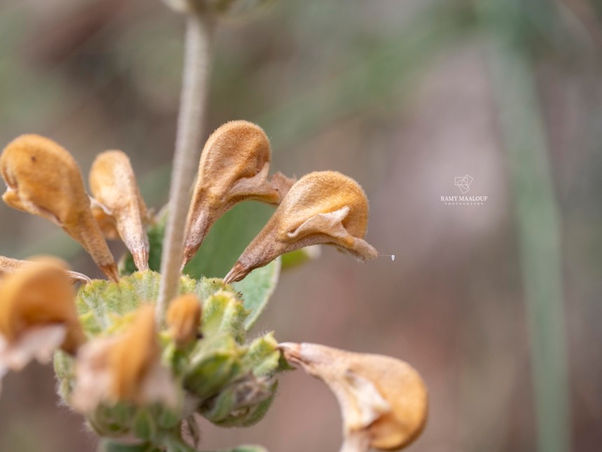Family |
Lamiaceae
Phlomis chrysophylla
Boiss.
Phlomis chrysophylla Boiss.
(First published in Diagn. Pl. Orient. 12: 89; 1853. Treated in Nouvelle Flore du Liban et de la Syrie, vol. 3, p. 134; 1983)
• Life-form & habit: Shrubby perennial, often multicaule, 30–100 cm or more, covered on sterile green shoots with a tomentum at first whitish, later turning golden yellow. Young shoots elongated.
• Leaves: Fertile shoots with green leaves, rugose beneath, petiolate, very obtuse, cordate.
• Inflorescence & flowers: One or two dense terminal pseudoverticillasters, multiflorous, surrounded by floral leaves equal to or longer than the inflorescence, deflexed. Bracts linear, numerous, appressed to calyces, about half their length. Calyx tomentose, whitish to golden yellow, angular, furrowed, truncate at the top, with limb reduced to five very short, obtuse cusps. Corolla golden yellow, more than twice as long as the calyx; upper lip somewhat retuse; filaments of the longer stamens appendiculate. Nutlets glabrous .
• Phenology: Flowers May–August.
• Habitat & elevation: Rocky slopes, montane to subalpine belts.
• Lebanese distribution: ‘Aïn Zehalta, Mdeireje, Jabal Kneissé, Faraya, Afqa, Jabal Qamoua, Douma, Bechnata, Ehden forest, Hasroun, Bcharré, Cedars of Hadeth, above Bcharré, ‘Aïnata, Hasbaya, Kfar Zeit, Qala‘at Chekif.
• Syrian distribution: Anti-Lebanon (Zebdani, Ouadi el-Qarn), Hermon (above Mejdel-ech-Chems), N Latakia (Kessab, Karadourane).
• Native range: Lebanon, Syria, Turkey. (POWO)
⚠️ Taxonomic note: Mouterde emphasized its recognition by the golden-yellow indumentum that develops on sterile shoots and calyces, in contrast with related species of Phlomis that retain greyish or whitish tomentum.





